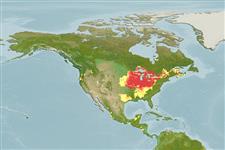Classification / Names
Common names | Synonyms | Catalog of Fishes (gen., sp.) | ITIS | CoL | WoRMS | Cloffa
Actinopterygii (ray-finned fishes) >
Perciformes (Perch-likes) >
Percidae (Perches) > Etheostomatinae
Etymology: Percina: Latin, diminutive of perch = perch (Ref. 45335); caprodes: Percina=a small perch; caprodes, Greek for resembling a pig (referring to the snout) (Ref. 79012).
Environment / Climate / Range
Ecology
Freshwater; benthopelagic. Temperate, preferred ?; 60°N - 30°N
North America: St. Lawrence-Great Lakes, Hudson Bay and Mississippi River basins from Quebec to Saskatchewan in Canada south to Gulf of Mexico; and Atlantic and Gulf Slope drainages in the USA.
Size / Weight / Age
Maturity: Lm ? range ? - ? cm
Max length : 18.0 cm TL male/unsexed; (Ref. 5723); common length : 12.5 cm TL male/unsexed; (Ref. 12193); max. reported age: 3 years (Ref. 12193)
Most common over gravel and sand in medium-sized rivers but can be found almost anywhere from small, fast-flowing rock-bottomed streams to vegetated lakes (Ref. 5723, 10294). Adults feed on larvae of midges, mayflies, caddisflies (especially hydropsychids), riffle beetles, stoneflies, limpets, and fish eggs (Ref. 10294). Eggs are found buried in the substrate (Ref. 7043).
Spawns in running water on sand or fine roots over sand (Ref. 7471). Eggs are found buried in the substrate (Ref. 7043).
Page, L.M. and B.M. Burr, 1991. A field guide to freshwater fishes of North America north of Mexico. Houghton Mifflin Company, Boston. 432 p. (Ref. 5723)
IUCN Red List Status (Ref. 115185)
CITES (Ref. 94142)
Not Evaluated
Threat to humans
Harmless
Human uses
More information
ReferencesAquacultureAquaculture profileStrainsGeneticsAllele frequenciesHeritabilityDiseasesProcessingMass conversion
Tools
Special reports
Download XML
Internet sources
